The term "ham" includes a broad category of meat products typically made from the hind legs of pigs. Butchers preserve ham meats through wet or dry curing methods, which employ salt and other seasonings to enhance the meat's flavor and extend its shelf life. Some hams are further processed by smoking, depending on the desired taste and texture. We explore the most popular types of ham so you can choose the best option for your restaurant.
- 1. Prosciutto
- 2. Pancetta
- 3. Capicola
- 4. Canadian Bacon
- 5. Jamon Iberico
- 6. Honey Ham
- 7. Black Forest Ham
- 8. Country Ham
- 9. Serrano Ham
- 10. Smithfield Ham
- 11. Gammon
- 12. Ham FAQ
Types of Ham
Discover the different varieties of ham and what distinguishes them from each other. From holiday favorites to regional specialties, there is a diverse range of hams befitting everything from breakfast menus to charcuterie boards.
List of Hams
Check out our list of the most popular hams. We provide detailed explanations of each variety, how it is cured, its flavor profiles, and what cut of pork it comes from.
1. Prosciutto

Prosciutto is a type of Italian dry-cured ham renowned for its rich flavor and tender texture. This meat comes from the hind legs of pigs, which are first salted and then air-dried for an extended period, usually between 9 to 18 months. Prosciutto has a sweet and salty flavor profile accented by fruity or earthy essences depending on the region where it's produced. In Italian, the word prosciutto translates directly to ham. There are different types of prosciuttos, the two most popular being prosciutto cotto and prosciutto crudo.
Thinly sliced prosciutto is usually served as an appetizer or antipasto and paired with cheese, olives, and bread. It adds depth of flavor to pasta sauces, salads, sandwiches, and pizzas. The color of prosciutto should range from brownish red to salmon pink and have strips of fat on each slice. The fat on premium prosciutto isn’t chewy and melts in your mouth. To ensure a quality product, look for DOP (Protected Designation of Origin) prosciutto produced by reputable manufacturers using traditional methods and superior ingredients like prosciutto di parma.
- Pork Cut: Hind leg
- Flavor Profile: Sweet and salty with subtle fruit and earth flavors
- Curing Method: Dry cured
2. Pancetta
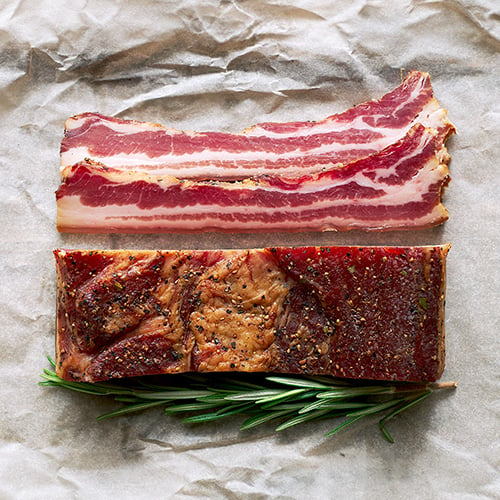
Technically an Italian variety of bacon, pancetta is made from pork belly and cured with salt, black pepper, nutmeg, fennel, and garlic. Unlike traditional American bacon, pancetta is not smoked and has a distinct savory and slightly sweet flavor. The curing process involves tightly rolling the meat and tying it with string before air-drying it for several weeks to months in a cool, dry place. The meat slowly dries out and develops its unique flavor profile. Some modern methods may involve using a curing chamber or refrigerator to control temperature and humidity levels. Nitrites are added to the meat to prevent harmful bacteria from growing and help preserve the meat. They also give pancetta its characteristic pink color and distinct flavor.
Pancetta is well-marbled and has a salty, meaty, and rich flavor profile. Depending on how it’s prepared, pancetta’s fatty pieces become either crispy or chewy. Pancetta is a widely used ingredient and a staple in everything from pasta sauces like carbonara to serving as an enhancement in risotto, salads, and sandwiches. Its rich flavor adds depth to soups, while its fat content helps keep meats moist while they cook. Due to its versatility, pancetta is a staple ingredient in many professional kitchens, providing chefs with a flavorful option for enhancing the taste of their dishes.
- Pork Cut: Belly
- Curing Method: Dry cured
- Flavor Profile: Meaty, fatty, and salty
3. Capicola
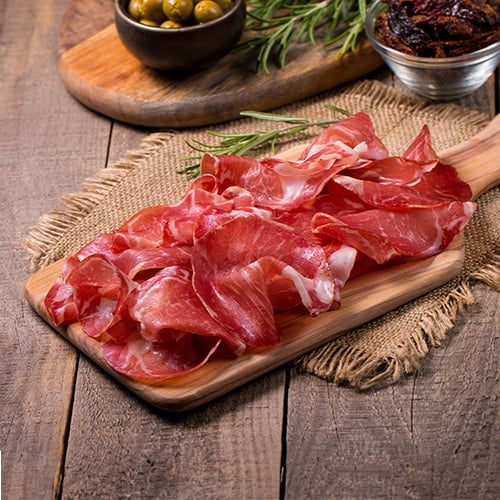
Capicola is a traditional Italian cured meat that is popular in delis and restaurants across the globe. It’s also known as coppa, capocollo, and (in New Jersey) gabagool. This specialty pork product comes from the neck fillet of the pig and is seasoned before being dry-cured and aged. Capicola is sliced thin and served as part of charcuterie boards, sandwiches, or antipasto platters. Its rich flavor profile, which combines elements of sweetness, saltiness, and spiciness, makes it a versatile ingredient that can elevate almost any dish.
There are two main types of capicola: hot and sweet. The spice blend for sweet coppa often includes cinnamon, nutmeg, cloves, bay leaves, and juniper berries. Spicy coppa is typically seasoned with cayenne pepper, garlic, red chili flakes, and paprika. No matter its seasoning, capicola offers a good ratio of meat to fat, and its paper-thin consistency will melt in your mouth.
- Pork Cut: Neck fillet
- Curing Method: Dry cured
- Flavor Profile: Can be sweet or spicy depending on its spice blend
4. Canadian Bacon

Canadian bacon, also known as back bacon, is a type of cured pork product popular in both Canadian and American cuisine. Unlike traditional bacon, which is made from pork belly, Canadian bacon is made from pork loin, a leaner pork cut with a different texture than classic bacon. What Americans know as “Canadian bacon” is considered “back bacon” in Canada. Peameal bacon is the traditional bacon in Canada.
Canadian bacon is a type of peameal bacon. Peameal bacon is made from boneless pork loin that is cured and then rolled in cornmeal. It is typically leaner and has a milder flavor than other types of ham. It’s commonly used in sandwiches, salads, and breakfast dishes. Canadian bacon is made from pork loin that is cured and smoked. It is typically sliced thicker than peameal bacon and has a slightly sweeter taste. Canadian bacon is often used as a topping for pizzas, in eggs benedict, or as a filling for sandwiches.
- Pork Cut: Loin
- Curing Method: Wet cured
- Flavor Profile: Mild, sweet, doesn’t crisp when cooked
5. Jamon Iberico

Jamon Iberico, also known as Iberian ham, is a highly prized and luxurious type of ham originating from Spain and Portugal. This premium ham is renowned for its exceptional flavor, texture, and unique curing process. The curing process of Jamon Iberico is a meticulous art that can take anywhere from 12 to 48 months (about 4 years), depending on the type and quality of the ham. During this time, the ham is salted, dried, and aged in a controlled environment to develop its complex flavors and aromas. Whether enjoyed on its own, paired with cheese and wine, or used in recipes, Jamon Iberico is a versatile and decadent ingredient that adds a touch of luxury to any dish.
There are three main categories of Jamon Iberico based on the breed of the pig and its diet: Jamon Iberico de Bellota, Jamon Iberico de Recebo, and Jamon Iberico de Cebo. Jamon Iberico de Bellota is considered the highest quality and most sought-after type, made from free-range Iberian pigs that roam oak forests and feast on acorns during the montanera season. This diet gives the ham a rich, nutty flavor and a marbled texture that melts in your mouth. Jamon Iberico de Recebo is made from pigs whose acorn diet is supplemented with grains and legumes. This type of ham offers a balance of flavors and a slightly firmer texture compared to Jamon Iberico de Bellota. Jamon Iberico de Cebo is made from pigs that are fed a diet of grains and commercial feed, resulting in a milder flavor profile and a firmer texture.
- Pork Cut: Hind legs of the black Iberico pig
- Curing Method: Dry cured
- Flavor Profile: Nutty, earthy, floral, and sweet
6. Honey Ham
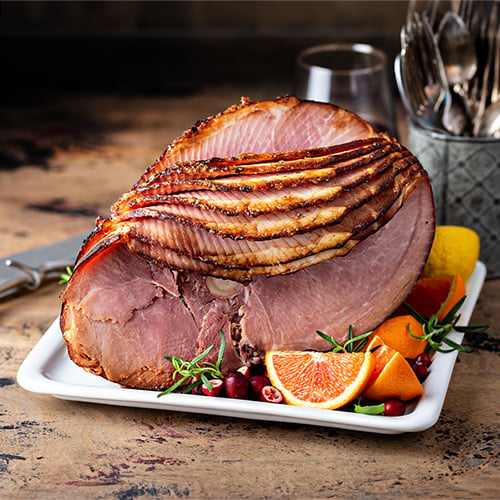
Honey ham is a popular variety of ham that is beloved for its sweet and savory flavor profile. It’s made from the shank, the lower half of the pig’s leg above the hock. The shank cut is tender and easy to carve. However, chefs must take care because it dries out easily when cooked. Honey ham is wet cured by soaking it in a brine solution that includes honey, sugar, and spices. Honey must make up at least half of the sweetening ingredient in the curing mix for it to be considered a honey ham. Not only does the honey add a touch of sweetness, but it also helps to create a caramelized crust when the ham is cooked, giving it a delicious glaze.
Honey ham is a versatile ingredient that can be enjoyed in various ways. It can be sliced and served cold in sandwiches or salads, or it can be heated and glazed for a warm and comforting main dish. Its sweet and salty flavor pairs well with a wide range of accompaniments, making it a popular choice for catering events, delis, and restaurants. When purchasing honey ham for commercial use, consider factors such as the quality of the meat, the ingredients used in the curing process, and any certifications or labels that indicate the ham meets certain standards.
- Pork Cut: Shank
- Curing Method: Wet cured
- Flavor Profile: Savory pork saturated in sweet honey
7. Black Forest Ham

Black Forest ham originates from the Black Forest region in Germany. It's known for its smoky flavor, black exterior, and deep red color. To create Black Forest ham, pork hind legs are carefully selected and trimmed before being cured with a blend of salt and a mix of spices such as juniper berries, coriander, and pepper. It's cured for up to three weeks, which creates its signature black exterior. The ham is then cold smoked over pine or fir wood, which imparts a unique aroma and flavor to the meat. One key characteristic of Black Forest ham is its distinct marbling, which comes from the high-quality pork used in the curing process. This marbling adds to the tenderness and succulence of the ham, making it a versatile ingredient in a variety of dishes.
In the European Union, Black Forest ham has been granted a Protected Geographical Indication (PGI). This designation ensures that only ham produced in the traditional manner and within the Black Forest region can be labeled as Black Forest ham. However, in the United States, there are no restrictions on the use of the term "Black Forest ham," allowing for a wider range of products to be labeled as such. When purchasing Black Forest ham in the U.S., the product probably is not an imported specialty item. Instead, it is typically a brine-cured and cold-smoked ham sourced from American pig farms. It may not even be smoked; it often has artificial smoke flavorings added to achieve a similar taste profile. If you want to offer true Black Forest ham in your restaurant, make sure you read your labels and investigate the manufacturer.
- Pork Cut: Top round muscle of the pig's leg
- Curing Method: Dry-cured and cold-smoked
- Flavor Profile: Smokey, salty and sweet
8. Country Ham

Country ham is a type of dry-cured ham that is typically associated with Southern cuisine in the United States. It has a bold flavor and employs a long history of preservation techniques. It’s made by rubbing a leg of pork with salt, sugar, and spices before aging it for six months to three years. One key characteristic of country ham is its intense saltiness, which comes from its curing process. While it cures it develops its trademark rich, savory flavor profile that sets it apart from other types of ham. The aging process also contributes to the unique taste and texture of country ham, as it becomes firmer and more concentrated in flavor over time.
Country ham is usually smoked over hickory or red oak wood, enhancing its natural flavors. However, some varieties of country ham like North Carolina’s “salt-and-pepper ham” are not smoked. Traditionally, country ham is sliced thin and served as a standalone dish or as a flavorful addition to a variety of recipes. It is commonly enjoyed as a breakfast meat. Add it to your offerings at your hotel’s continental breakfast or pair it with biscuits at your homestyle diner. It is also an excellent addition to comforting soups, stews, and casseroles. Overall, country ham is a beloved ingredient in Southern cooking and beyond, prized for its robust taste and versatility in various culinary applications.
- Pork Cut: Hind leg
- Curing Method: Dry cured and smoked
- Flavor Profile: Salty, dry, and smokey
9. Serrano Ham
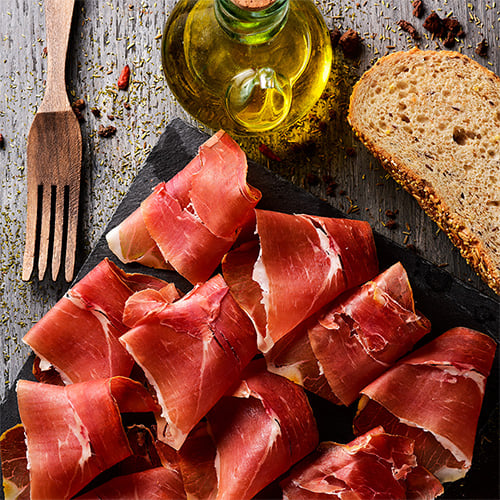
Serrano ham, also known as jamon serrano, is a type of dry-cured Spanish ham. It's highly prized by chefs for its rich flavor and delicate texture. It's made from the hind leg meat of white pigs, specifically the Landrace or Duroc breeds, which are raised in Spain under strict guidelines to ensure their quality and authenticity. The production process of serrano ham is a time-honored tradition that involves salting the meat and then air-drying it in a cool, high-altitude location for a minimum of nine months. On most occasions, it's dry-cured for 12 to 18 months. During the curing process, the ham develops its distinctive flavor profile, characterized by a perfect balance of saltiness and sweetness with a hint of nuttiness.
Serrano ham is often compared to Italian prosciutto, but it has unique characteristics that set it apart. The flavor of serrano ham is more intense and complex than prosciutto, making it a popular choice for tapas, charcuterie boards, and other gourmet dishes. Its versatility in both traditional Spanish cuisine and modern gastronomy has made serrano ham a staple in restaurants worldwide. When selecting serrano ham for your establishment, look for hams with a deep red color and marbled fat, as these indicate quality and superior flavor. Proper storage and handling are crucial to preserving its integrity, so keep it in a cool, dry place and slice it thin right before serving it.
- Pork Cut: Hind leg
- Curing Method: Dry cured
- Flavor Profile: Salty, buttery, earthy, and barbequed flavor with a delicate texture
10. Smithfield Ham

Smithfield ham is a beloved variety that originates from Smithfield, Virginia. This ham is a staple in Southern cuisine and is highly regarded for its unique flavor and quality. Smithfield ham is made from the hind leg of a pig that is dry-cured with salt and sodium nitrate for 30-37 days. Then, it’s spiced with black pepper before it’s cold smoked at 70 to 90 degrees Fahrenheit for another 10 to 15 days.
One distinguishing characteristic of Smithfield ham is its long curing process, which can last anywhere from several months to over a year. This extended curing time allows the flavors to develop fully and results in a rich, savory taste. It is often enjoyed thinly sliced and served as a standalone dish or as an ingredient in various recipes. Its bold flavor profile makes it a popular choice for adding to classic southern dishes like black-eyed peas, Brunswick stew, and collard greens.
- Pork Cut: Hind leg
- Curing Method: Dry-cured and cold-smoked
- Flavor Profile: Salty, robust meat flavor
11. Gammon
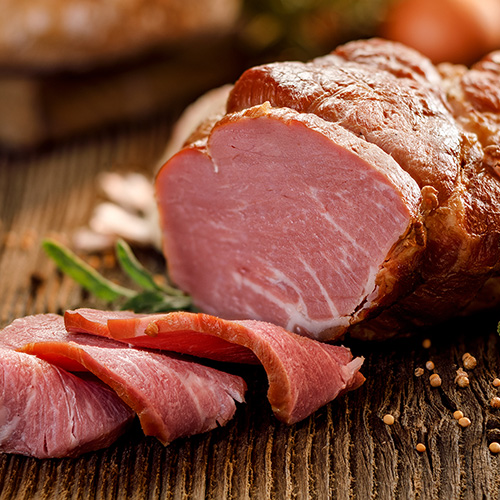
Gammon is a British English word that refers to cured pork hind leg meat. It’s typically wet-cured in a brine solution that contains salt, sugar, and various spices. This process gives gammon its distinct flavor and moist texture. Dry-cured ham tends to have a firmer texture and a more intense flavor compared to wet-cured ham.
Thanks to the brining process, gammon is known for its slightly sweet and salty flavor profile. It pairs well with fruity glazes and sauces, making it a versatile ingredient in both savory and sweet dishes. Gammon is sold raw and requires cooking before consumption. It is often boiled, grilled, or roasted and served with a sweet glaze at holiday meals.
- Pork Cut: Hind leg
- Curing Method: Wet cured
- Flavor Profile: Sweet and salty with clove, cinnamon, and star anise essences
Ham FAQ
Now that you’re familiar with the most popular types of ham, you might have some further questions about how ham is made or the subcategories within each type. Use our ham FAQs to gain a deeper understanding.
How Is Ham Made?
Ham production typically begins with the selection of high-quality pork cuts, commonly the hind leg of the pig. The curing process is a crucial step, where the meat is either dry-cured or wet-cured. Dry-curing involves applying a mixture of salt, sugar, and other seasonings directly onto the meat's surface, while wet-curing involves immersing the meat in a brine solution. After the curing process, the ham is often smoked to enhance its flavor and preserve it. Smoking can be done using various types of wood, such as hickory or applewood, to impart different flavors to the meat. The smoking process can take several hours to days, depending on the desired intensity of flavor.
Once the curing and smoking processes are complete, the ham is typically aged to further develop its flavors. Aging can range from a few weeks to several months, with some premium hams undergoing aging processes that last for years. The final step in ham production is the slicing and packaging of the meat. Hams can be sliced into various thicknesses, from thin deli slices for sandwich shops to thicker cuts for roasting or grilling. Packaging can vary depending on the type of ham and its intended use, with options ranging from vacuum-sealed packs to whole hams for carving in commercial kitchens.
What Is the Difference between Prosciutto Cotto and Crudo?
Prosciutto cotto and prosciutto crudo are the two most common types of prosciuttos. While both are delicious options, they have distinct characteristics that set them apart. Prosciutto cotto, which translates from Italian as cooked ham, is slow-cooked at controlled temperatures and served thinly sliced. It’s often seasoned or brined with herbs, spices, and truffles and has a delicate flavor and a moist texture. Prosciutto crudo, which translates from Italian as raw ham, is a dry-cured ham that is aged for an extended period. It’s sliced paper thin, practically melts in your mouth, and has a sweet and salty flavor profile. Prosciutto crudo is best enjoyed on its own or paired with other complementary flavors such as melon or cheese.
What Is Proscuitto Di Parma?
Prosciutto di Parma is a renowned Italian dry-cured ham that holds a Protected Designation of Origin (PDO) status, signifying its authenticity and quality. Produced exclusively in the Parma region of Italy, this delicacy is highly regarded for its exceptional flavor and traditional craftsmanship. To create Prosciutto di Parma, only specially selected pork legs from heritage-bred pigs are used, and the meat is carefully salted and left to cure for a minimum of 12 months. The unique microclimate of the Parma region, with its gentle breezes from the Apennine Mountains, plays a crucial role in the aging process, resulting in the distinct flavor profile that sets prosciutto di parma apart. When sourcing Prosciutto di Parma for your establishment, look for the official Parma Crown logo on the packaging, which guarantees that the product meets strict production standards and has undergone rigorous quality checks.
What Is the Difference between Pancetta Arrotolata and Pancetta Tesa?
There are two main types of pancetta: pancetta arrotolata and pancetta tesa. While both varieties share similarities in terms of flavor and texture, there are key differences that set them apart. Pancetta arrotolata, also known as rolled pancetta, is made by rolling the pork belly into a tight cylinder and then curing it with a blend of salt and spices. The curing process can take several weeks to months, depending on the desired flavor profile. Pancetta arrotolata is commonly used in recipes where the distinct marbling and layers of fat add depth and richness to dishes.
Pancetta tesa, or flat pancetta, is prepared by curing the pork belly in a flat, rectangular shape. The meat is seasoned with salt and spices, then pressed and air-dried to develop its signature flavor. Pancetta tesa is often sliced thinly and used as a flavorful addition to pasta dishes, salads, and charcuterie boards. Whether you prefer the cylindrical shape of pancetta arrotolata or the flat slices of pancetta tesa, both varieties are versatile ingredients that can elevate the flavor profile of your culinary creations.
Back to TopTo choose the best type of ham for your commercial kitchen, you must first consider factors such as flavor, texture, and versatility. From the rich and savory taste of prosciutto to the smoky and salty flavor of country ham, there are a variety of options to suit different culinary needs. Whether you're looking to add a gourmet touch to your charcuterie board or enhance the flavor profile of your signature soup, the diverse selection of ham varieties available ensures that you can find the perfect option to elevate your menu offerings.



